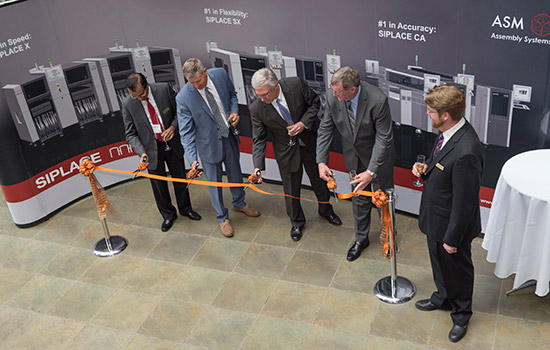RIT celebrates manufacturing partnership
ASM and CEMA to provide research, workforce development and student opportunities for advancing the electronics packaging industry
Elizabeth Lamark
Opening “Enabling the Digital World,” a half-day university-corporate event focused on the latest trends in electronics packaging, were (left to right) Manian Ramkumar, interim dean of RIT’s College of Applied Science and Technology; Ryne Raffaelle, vice president of research at RIT; Joseph Hamm, regional director, New York State Department of Labor; Jeff Timms, CEO and general manager, ASM Americas; and Martin Anselm, director of RIT’s Center for Electronics Manufacturing and Assembly.
Energy management, security, transportation and health care are just a few of the industries being improved through integration of next-generation electronics technology and systems.
“A fourth industrial revolution is underway and we have to rethink the way we do things because the role of manufacturing is changing dramatically,” said Jeff Timms, one of the keynote speakers at “Enabling the Digital World: The Future of Electronics and Manufacturing” a half-day event that took place last week at RIT.
Timms, chief executive officer and general manager of ASM Americas, was among a group of industry leaders and RIT researchers who detailed new trends in electronics manufacturing and the need to have a new and highly skilled workforce to meet the challenges of developing and applying this technology.
Co-presented with ASM and RIT’s Center for Electronics Manufacturing and Assembly (CEMA), the event was a means to recognize the expansion of the university-corporate partnership with ASM Assembly Systems and a focus on next-generation electronics manufacturing, research and workforce development.
“Our role as a provider of world-class systems has to be more collaborative. We have to be partnering with the industries that we serve, and we have to take much more interest in the education of the workforce because it is changing,” said Timms to the audience of nearly 100 industry leaders from around the state, faculty and students at the event.
ASM, an international supplier of electronics assembly and packaging equipment, installed two machines in the CEMA lab—a DEK printer, which precision-prints solder paste, and a SIPLACE SX2 pick and place machine for flexible, high-speed surface-mount technology component placement. The new equipment expands CEMA’s capabilities in electronic manufacturing and RIT’s overall contributions to AIM Photonics, specifically in the area of next-generation electronics devices and packaging, positioning both organizations to contribute to the growing industry.
CEMA was established at RIT in 1995 and provides workforce training, development, prototype testing and research for the electronics manufacturing and packaging industry. Its corporate partners represent companies locally and nationally.
“Over the years, the center has conducted many applied research projects and has published its results for the benefit of the industry as well as helped graduate well-trained engineers both at the graduate and undergraduate levels,” said Manian Ramkumar, interim dean of RIT’s College of Applied Science and Technology, where the CEMA lab is housed. “With this new partnership, all of these activities are poised to continue into the future to support the rapid growth of the electronics and its proliferation in all walks of life.”
Surface-mount technology is expected to exhibit significant growth at a rate of 8.9 percent between 2017 and 2022 and is expected to reach $5.4 billion in market share by 2022, according to the Market and Markets Research Group.
“ASM Assembly Systems is identified in this research as one of the key players in the market and its growth. And we are proud to have been selected by the ASM team to be one of your partners to join in this advancement,” said Ramkumar.
Central activities of the day also included an experts panel led by Irene Sterian, executive director of ReMAP, a network of technology centers of excellence in Canada. She discussed the culture of electronics, manufacturing and research and how electronics will be fully integrated into next-generation technologies such as the Internet of Things, autonomous vehicles, wearable technologies and renewable energy. Participants were able to tour CEMA and see demonstrations of state-of-the-art electronics packaging equipment throughout the afternoon. Student-researchers presented results from projects taking place in the CEMA Laboratory specifically about adhesives used for photonics applications, solder paste printing, standards implementation and cost-effective alternatives to soldering pastes using varied alloys.















